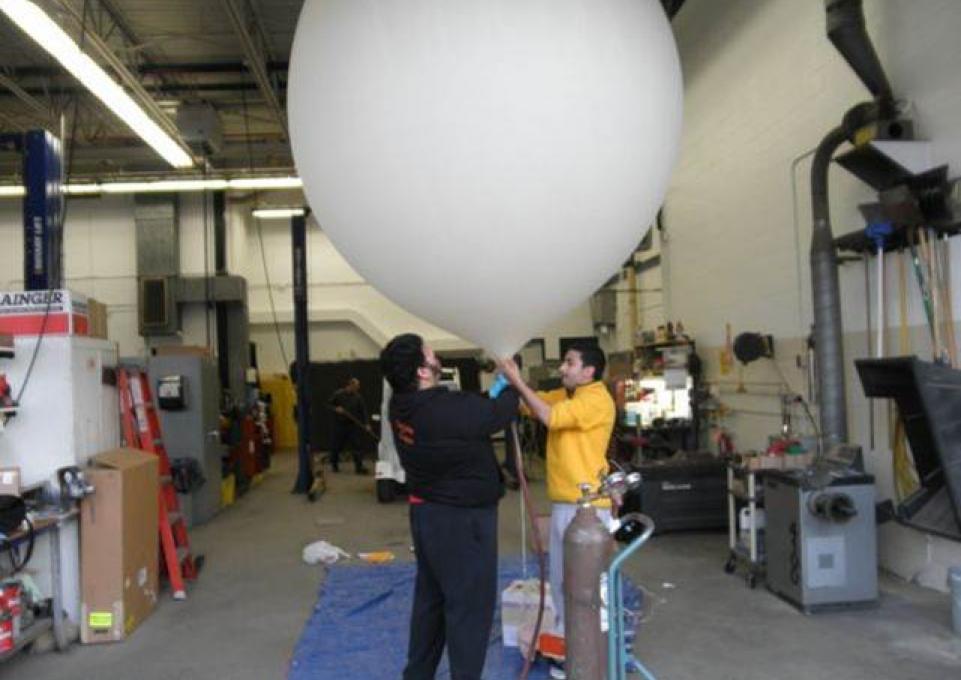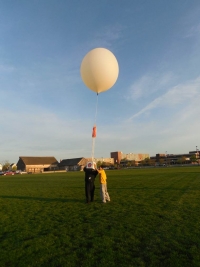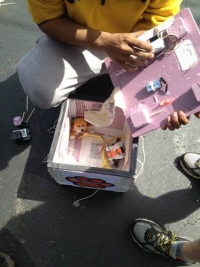
Last spring, students Edward Bryant and Mike Al-Zoubi sent an unmanned helium balloon to space. Its name: Bengal I. “Now we can say we are the only people with Buffalo State lanyards that have been to space,” said Bryant.
 The project began as an assignment for their University Physics I class. The goal was to design a project that would last all semester, culminating in a final presentation. “Our professor, Dr. MacIsaac, told us to be as creative as we could,” said Bryant, “and I thought ‘I want to send a balloon to space.’” Bryant and Al-Zoubi were not certain if their idea was feasible, but filled with the romance of sending something to space, they charged head-first into the planning stages.
The project began as an assignment for their University Physics I class. The goal was to design a project that would last all semester, culminating in a final presentation. “Our professor, Dr. MacIsaac, told us to be as creative as we could,” said Bryant, “and I thought ‘I want to send a balloon to space.’” Bryant and Al-Zoubi were not certain if their idea was feasible, but filled with the romance of sending something to space, they charged head-first into the planning stages.
“We started by simply writing down ‘high altitude balloon, 100,000 feet,’” said Bryant. “It turns out there are a lot of amateur groups that embark on this kind of project.” At that altitude the balloon would be 19 miles high and reach the stratosphere. That’s more than twice the cruising altitude of a Boeing 747.
“As we progressed, we had to understand things we hadn’t been taught yet,” said Bryant. “We had to learn a lot from scratch.” The scope of this project was reaching a magnitude that Bryant and Al-Zoubi had not anticipated, but rather than turn back, they pushed forward.
Bryant and Al-Zoubi turned to various other campus departments for help. The Chemistry Department provided helium. Stephen Vermette, professor of geography and planning, had students calculating flight paths for a month prior to launch. The Federal Aviation Administration (FAA) was involved to ensure safety. “The FAA classifies this as an unmanned aircraft, so we had to receive a waiver for the rules that govern unmanned flight,” said Bryant, “and we had to contact nearby air traffic control before we launched.” Bryant and Al-Zoubi even relied on the kindness of strangers for parachute tests. “We knocked on a random door on the seventh floor of the Student Apartment Complex, told them who we were, what we were doing, and asked if they’d let us drop parachutes from their window,” said Bryant.
 This collaboration encouraged Bryant and Al-Zoubi to continue with their project and led to a successful conclusion. “We found the payload 36 miles from the launch site,” said Al-Zoubi. “We were lucky to find it.” The payload and its contents remained intact. Bryant and Al-Zoubi were able to collect data from onboard instruments that measured altitude, temperature, and pressure. Also in the box were a video camera and personal effects such as Buffalo State lanyards for souvenirs.
This collaboration encouraged Bryant and Al-Zoubi to continue with their project and led to a successful conclusion. “We found the payload 36 miles from the launch site,” said Al-Zoubi. “We were lucky to find it.” The payload and its contents remained intact. Bryant and Al-Zoubi were able to collect data from onboard instruments that measured altitude, temperature, and pressure. Also in the box were a video camera and personal effects such as Buffalo State lanyards for souvenirs.
Dan MacIsaac, associate professor of physics said, “They have shown remarkable stick-to-itiveness on this project.”
Bryant and Al-Zoubi are already hard at work designing Bengal II. “Bengal II is going to be much more focused on experiments,” said Bryant, “but I want to emphasize collaboration. I want to involve every department that wishes to do experiments onboard. I want the art department to design the logo. When we grow as a university, it’s a result of this kind of basic student research.”
